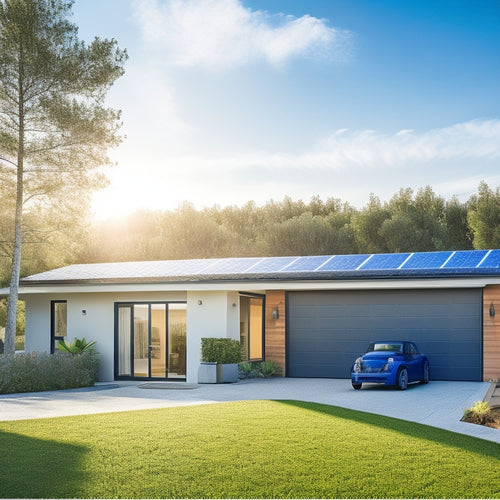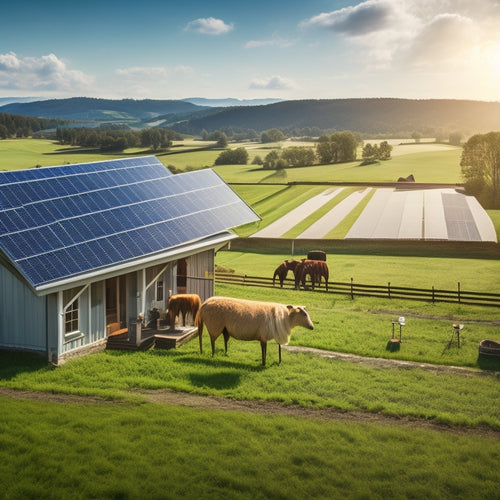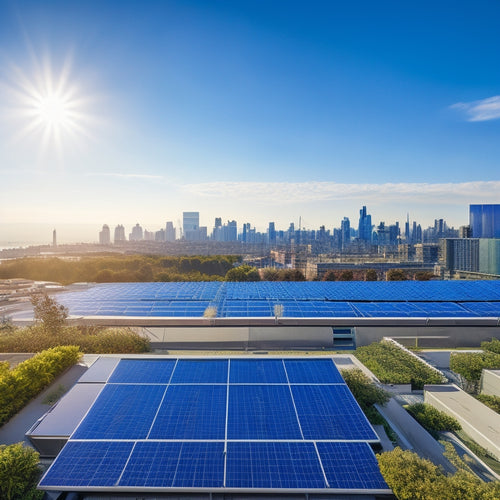
Optimizing Your Solar Panel System for Maximum Efficiency
Share
To optimize your solar panel system for maximum efficiency, you'll want to prioritize regular cleaning and inspection, monitoring system performance data, and implementing energy efficiency optimization strategies. Make sure your system is free from debris and shading, and that components are up-to-date and functioning properly. By leveraging data analytics and performance benchmarking, you'll be able to identify areas for improvement and make data-driven decisions. As you fine-tune your system, you'll uncover even more ways to maximize its potential – and we'll show you how to access them.
Key Takeaways
• Regularly clean and inspect your solar panel system to prevent debris accumulation and ensure maximum energy production.
• Monitor system performance data to identify issues, optimize settings, and maintain peak efficiency.
• Implement thermal management strategies and optimize system design to minimize energy losses and increase output.
• Prevent shading and reflection by trimming trees, optimizing roof orientation, and avoiding obstructions.
• Regularly inspect and upgrade components to ensure reliable operation and maximize energy efficiency.
Regular Cleaning and Inspection
Every 6-12 months, you should inspect your solar panel system to identify and address potential issues, and clean the panels to guarantee maximum energy production.
Regular cleaning is essential to prevent debris accumulation, which can reduce energy output by up to 25%. Dirt, dust, and other contaminants can block sunlight, decreasing the system's efficiency. Additionally, neglecting cleaning can lead to hotspots, causing premature wear and tear on your panels.
When cleaning, use water conservation techniques to minimize water waste. A gentle rinse with a soft-bristled brush and a mild soap solution is sufficient. Avoid using harsh chemicals or abrasive materials that can damage the panels' surface.
Monitoring System Performance Data
How closely are you tracking your solar panel system's performance data to confirm it's operating at peak efficiency? Accurate monitoring is vital to identify areas for improvement and guarantee your system is generating maximum power output.
By leveraging data analytics, you can gain valuable insights into your system's performance and pinpoint potential issues. Performance benchmarking is essential to evaluating your system's efficiency and making data-driven decisions.
You should be monitoring key performance indicators (KPIs) such as energy output, voltage, and temperature. Advanced monitoring systems can provide real-time data, enabling you to respond promptly to any anomalies or underperformance.
By analyzing this data, you can identify trends, optimize system settings, and schedule maintenance accordingly. Additionally, data analytics can help you identify opportunities to improve your system's design and configuration, leading to enhanced overall efficiency.
Energy Efficiency Optimization Strategies
To maximize your solar panel system's energy output, you can implement various optimization strategies that target specific components and operational parameters. By doing so, you'll be able to identify and address potential bottlenecks, guaranteeing your system operates at peak efficiency.
Some key strategies to focus on include:
-
Inverter sizing: Proper inverter sizing is essential to make sure that your system can handle the maximum power output of your solar panels. Undersized inverters can lead to energy losses, while oversized inverters can increase costs.
-
Thermal management: High temperatures can greatly reduce your solar panels' efficiency. Implementing effective thermal management strategies, such as using heat sinks or cooling systems, can help lessen these losses.
-
Component selection: Choosing high-efficiency components, such as premium solar panels and optimized mounting systems, can also contribute to increased energy output.
Preventing Shading and Reflection
By optimizing your solar panel system's design and layout, you can minimize shading and reflection, which can greatly reduce energy output. Shading from trees, buildings, or other obstructions can have a substantial impact on your system's efficiency. Regular tree trimming is essential to prevent branches from casting shadows on your panels. Consider hiring a professional to trim trees that are within 20 feet of your solar array.
Roof orientation is also vital in minimizing shading. Make sure that your roof faces the best direction (south in the Northern Hemisphere) and has a suitable pitch to allow snow to slide off easily. Additionally, avoid installing panels near chimneys, vents, or skylights, as these can create shadows and reduce energy production.
Reflection from surrounding surfaces, such as white roofs or walls, can also affect your system's performance. Consider using a matte finish or applying a non-reflective coating to minimize reflection.
Upgrading and Replacing Components
You should regularly inspect your solar panel system's components to identify opportunities for upgrading or replacing them, as outdated or faulty parts can greatly compromise your system's energy output. This proactive approach guarantees your system operates at peak performance, maximizing your return on investment.
Some key areas to focus on include:
-
Inverter overhaul: Upgrade to a newer, more efficient inverter model to reduce energy losses and improve overall system performance.
-
Battery upgrade: Replace outdated or worn-out batteries with newer, higher-capacity models to increase your system's energy storage capabilities.
-
Component refurbishment: Identify and replace worn-out or damaged components, such as connectors, fuses, or switches, to prevent system failures and ensure reliable operation.
Frequently Asked Questions
Can I Install Solar Panels on a Metal or Asphalt Roof?
You're wondering if you can install solar panels on a metal or asphalt roof? Yes, you can! Both roof materials require specialized installation methods, such as clamping systems for metal roofs and adhesive flashing for asphalt roofs.
How Do I Optimize Solar Panels for Foggy or Cloudy Areas?
When optimizing solar panels for foggy or cloudy areas, you'll want to take into account Foggy Day Performance and Cloud Cover Impact, ensuring your system's design and tilt angle maximize energy production despite reduced sunlight.
Are There Any Solar Panel Systems Suitable for Rental Properties?
When considering solar panels for rental properties, you'll want systems designed for flexibility, like portable units or leasing options, which provide benefits for both you and your landlord, including flexible rental agreements and increased property value.
Can I Use My Solar Panel System With a Septic System?
You can use your solar panel system with a septic system, but make sure proper Septic Maintenance to avoid waterlogging, which can compromise your septic's efficiency; prioritize Water Conservation to minimize wastewater generation.
Do Solar Panels Work Well With Skylights or Translucent Roofs?
"As you consider solar panels with skylights or translucent roofs, assess roof obstructions carefully, ensuring they don't cast shadows on your panels. Natural lighting can complement your system, but precise placement is key to maximize energy harvesting."
Related Posts
-

Solar Energy Storage Options for Homes
When considering solar energy storage options for your home, you'll find several effective solutions. Battery systems...
-

Solar Power Systems for Rural Properties
Solar power systems offer a reliable and efficient energy solution for rural properties, allowing you to gain energy ...
-

Business Solar Investments for Cost-Effective Sustainability
Investing in solar energy is a smart move for your business, providing a solid foundation for cost-effective sustaina...


